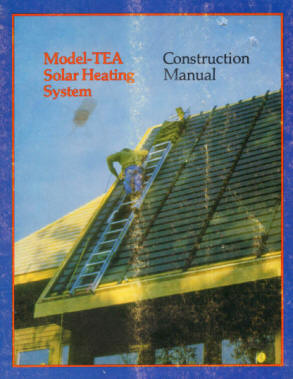
Search
The Renewable Energy site for Do-It-Yourselfers
TEA Solar Heating
System - Construction Manual

The TEA solar air heating collectors
described in this book are very well thought out designs. The TEA system
uses solar
air heating collectors that are integrated with the building's roof or wall to make a
highly efficient, cost effective, and long lived solar heating system. The collectors
are simple, relatively straight forward to build, and look great. These collectors were developed by
TEA in the late 70's and were the culmination of an extensive design and testing
program.
The authors of the book are Peter
Temple and Jennifer Adams. I want to thank Peter for his permission to
allow this material to be made available for download. Peter
is currently teaching classes in Building Science and Super Energy-Efficient
Building Design at Keene State College Architecture Department. Peter also
works as an building energy consultant, including buildings with near net-zero
energy use.
Some things to like about TEA collector design and the
Construction manual:
-
It provides well thought out designs for
large roof and wall integrated collectors.
-
The collector designs are straight
forward, and use commonly available materials and tools. Ordinary
house building skills, tools are all that is required to build these
systems.
-
Extensive testing was done to
validate the collector design and materials used.
-
The roof/wall integrated design
reduces material use, and reduces collector cost and labor.
-
The design can be
tailored to an individual home's roof or wall size and shape.
-
The manual includes details on
a full solar air heating systems, including: collector, storage, ducting
system, and control system. Designs for both new construction and
retrofit are covered.
-
The collector provides good
performance, which was validated by actual testing.
-
The manual includes
information on how to size the system, how to construct the system, and a
full set of detailed construction drawings.
The book describes a full solar home
heating system that includes a large collector, a heat storage system, and
a ducting and control system to connect all this together -- this will be a big
project for anyone. But, as the book points out, a more modest sized
collector can be used without a heat storage system, and with a much simpler
control and duct system. This smaller system could be a very manageable
project for either new construction or retrofit, and could still put a sizable
dent in your heating bill. In a passive solar house design, adding such a
small system could improve the solar fraction significantly.
For people with existing homes that
have available south facing wall space, retrofitting the wall collector could be
very attractive. The TEA collectors use vertical supply and return
manifolds located on the left and right ends of the collector, which seem more
suited to retrofit situations than the usual collector designs with vents or
manifolds along the top and bottom.
In spite of the 30 years that have
passed since these
collectors were designed, there is little in the design that is out of date.
But, here
is a list of changes that one might consider based on materials and design practices that
have changed some over the years since these collectors were developed ...
Download the Book
Click on the headings below to
download pdfs for each chapter.
Cover and Preface...
(0.8 MB pdf)
Table of Contents and
Introduction ... (1.2 MB pdf)
Chapter 1:
Description of the MODEL-TEA... (0.8 MB pdf)
Chapter 2:
Design Rationale... (2.5 MB pdf)
Chapter 3: Choosing and
Planning... (1.1 MB pdf)
Chapter 4: Sizing and
Engineering... (1.5 MB pdf)
Chapter 5:
Constructing the Roof Collector... (3.2 MB pdf)
Roof Collector Drawings... (2.2 MB pdf)
Chapter 6:
Constructing the Wall Collector... (3.7 MB pdf)
Wall
Collector Drawings... (1.9 MB pdf)
Chapter 7:
Constructing the Rock Bin... (2.1 MB pdf)
Rock Bin
Drawings... (2.0 MB pdf)
Chapter 8:
MODEL-TEA System Control Wiring... (2.2 MB pdf)
Chapter 9:
Design Options... (0.6 MB pdf)
Appendix A: Materials
Appendix A1
Discussion of Materials... (0.7 MB pdf)
Appendix A2
List of Materials and Manufacturers... (0.5 MB pdf)
Appendix A3 How to Build A Back-Draft Damper... (0.3 MB pdf)
Appendix
B and C References and Resources ... (0.5 MB pdf)
The scans are done such that each
page is an exact image of the page in the book with the OCR read text under the
image. This preserves the exact content of the book, while also allowing
text searches.
Gary May 25, 2009

